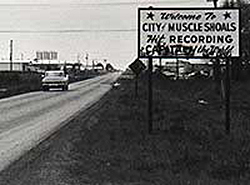This article is the second in a series on the historic Muscle Shoals studios. The first part is available here.
After signing Jimmy Cliff to Island Records in 1971, label owner and producer Chris Blackwell was determined to introduce Cliff to wider audiences both in America and Europe.
Deciding it might help to cut some songs with more of an R&B flavor, he brought Cliff to Muscle Shoals where, according to Hawkins, “we cut six, eight, maybe even ten songs.”
Several cuts, including “Sitting in Limbo,” ended up on the soundtrack of the cult reggae film, “The Harder They Come.”
Says David Hood: “Jimmy brought a bunch of Jamaican records with him-old ska singles, by the Upsetters and groups like that.”
“We were amazed by that sound, and it showed us a few things, like the ways to turn the beat around. It planted a seed with us.”
That seed came to fruition quickly with the Staple Singers hit, “Respect Yourself,” a lively blend of American R&B and classic reggae rhythm.
Cliff’s hits were sleepers, but Blackwell soon came back for another round. He had the English supergroup Traffic under his wing, a brilliant but unstable aggregation that seemed to be falling apart from the outset.
By that time, drummer Jim Capaldi had decided to move from behind the drums to front man, and the group had never really filled the bass player slot.
Blackwell recruited the reluctant duo of Hood and Hawkins, booking the studio solid for the duration of the 1972 summer tour to ensure their cooperation.
Jimmy Johnson came along to mix FOH, while Barry Beckett took an excursion to L.A.
After U.S. and European tour legs, they all returned to Muscle Shoals to record “Shootout at the Fantasy Factory”-a quickie that the Alabama contingent found unsatisfying.
“We had never seen anything like them,” says Hood. “Chris Wood was freaking out in one direction, Reebop was freaking out in another, Winwood was becoming a recluse and Capaldi was determined to play the rock star role. Roger and I struggled to keep things together. We tried to build a solid foundation that they could go crazy over.”
Simon South, Simon North
Despite the frenetic pace of the Traffic tours, the experience helped Hood and Hawkins hone their chops for their next superstar sessions.
When Paul Simon ventured into Muscle Shoals, he had four seasoned pickers ready to pounce on him.
“When he come down here to our turf, we jumped right in and knocked his hat in the creek,” says Johnson. “This wasn’t his usual style of recording, where he gets to call all the shots.”
Recalls Hawkins, “He had heard “I’ll Take You There” by the Staples, and thinking it was Jamaican backing, he called Stax to find out where it was done.
Then he called us, planning to come down for just one tune, “Take Me to the Mardi Gras.” Well, we knocked that out in two takes, and he was just amazed.”
“He started playing some other songs, we told him which ones we liked, and we cut them. That’s why we got co-production credits.”
Those sessions also produced “Kodachrome” and “Loves Me Like a Rock.” But when he invited the rhythm section to come to New York for “Still Crazy After All These Years,” the magic dissolved. Simon reverted to total control mode, and progress on the tracks slowed to a crawl.
“He made us so paranoid that we were afraid to play,” laments Hood.




















